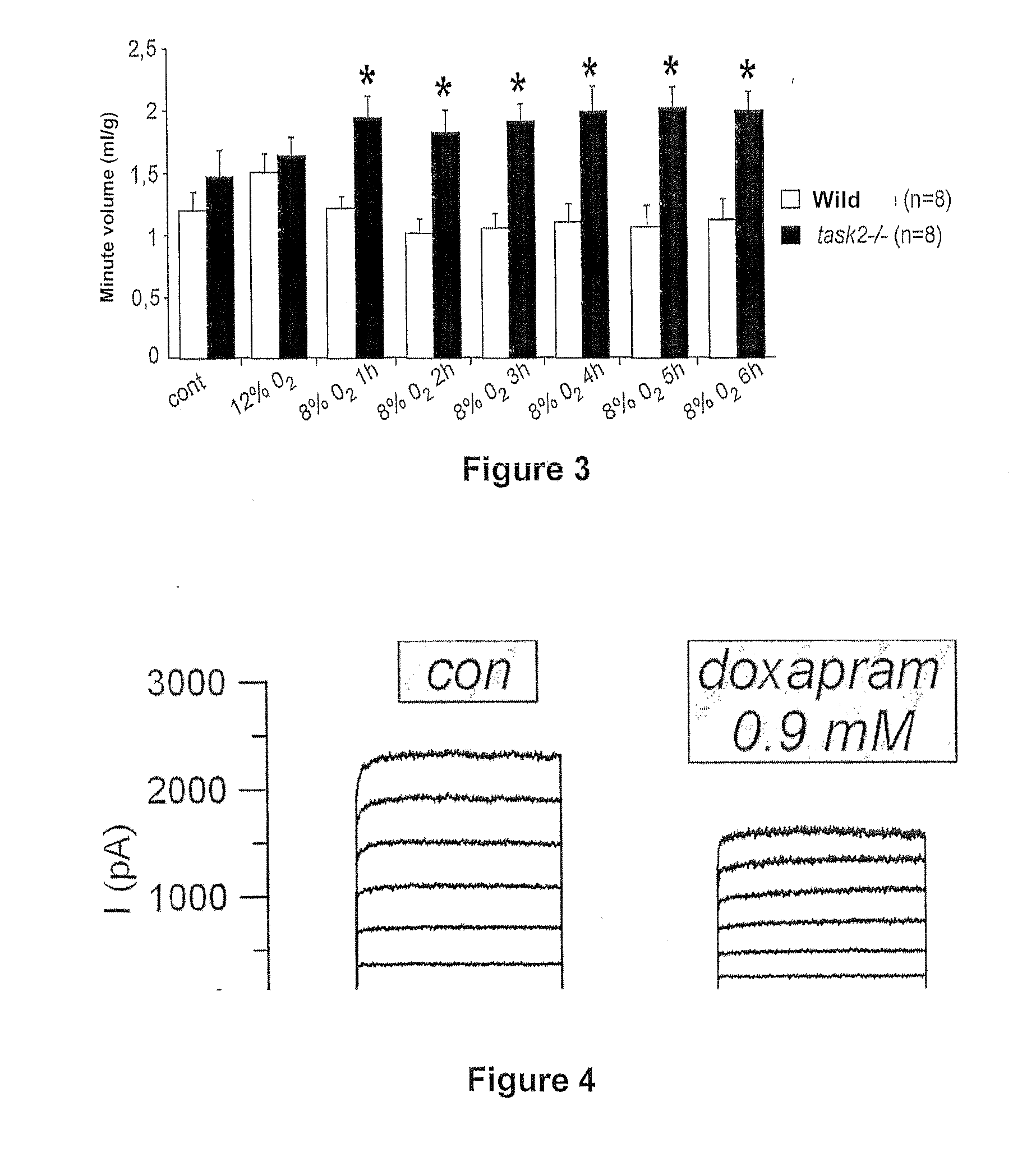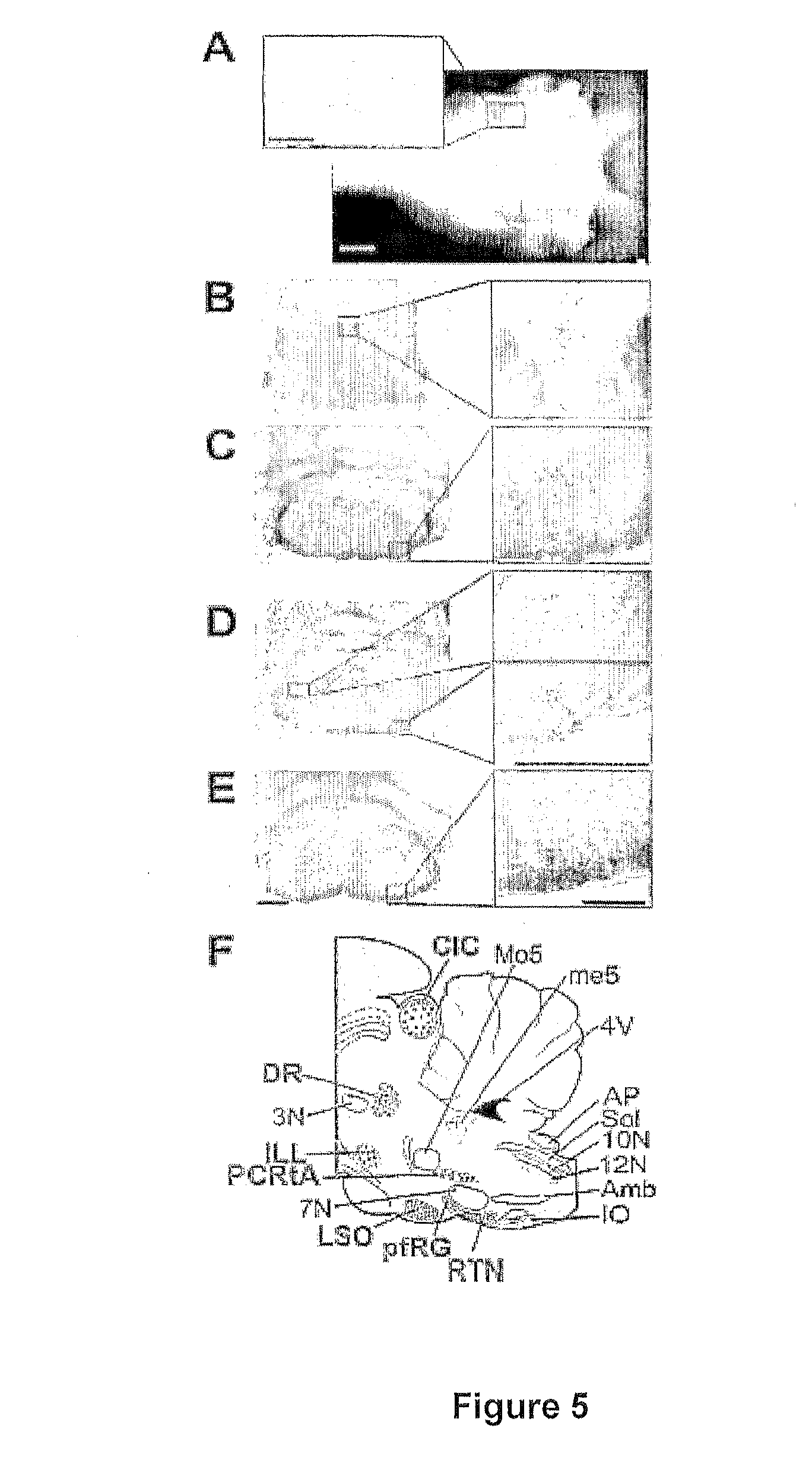Method of screening for compounds that can be used for the treatment of respiratory conditions
a technology for respiratory conditions and compounds, applied in the field of screening for compounds that can be used for the treatment of respiratory conditions, can solve the problems of reducing the concentration of arterial oxygen, affecting the quality of life of patients,
- Summary
- Abstract
- Description
- Claims
- Application Information
AI Technical Summary
Benefits of technology
Problems solved by technology
Method used
Image
Examples
example 1
Demonstration of the Expression of Task-2 in Brain Stem Neurons
[0069]The experiments in this example demonstrate the presence of TASK-2 channels in a major nerve structure belonging to the respiratory centres of the brain stem.
[0070]These experiments were carried out with mutant adult heterozygote mice (TASK-2+ / −). The TASK-2 gene that is invalidated is replaced by a sequence coding for an enzyme, beta-galactosidase, Thanks to this enzyme, the cells that normally express the TASK-2 channels may easily be identified by the classic histochemical detection technique using X-Gal as substrate that turns blue when hydrolysed.
[0071]After a fixation protocol with para-formaldehyde, a sample of the nerve tissue is taken and then the X-GAL detection technique is carried out on 30 μm thick transverse sections of the brain stem, obtained with a cryostat. At the end of this reaction, the cells expressing the TASK-2 channels are coloured blue (arrow in FIG. 1).
[0072]The results obtained reveal th...
example 2
In Vitro Demonstration of the Intervention of TASK-2 Channels in the Central Mechanisms of the Adaptation of Respiration
[0074]In this example, the inventors used wild type mice (active TASK-2 channels) and mutant TASK-2 mice that do not express active TASK-2 channels (− / −>>). These mice were initially produced by the W. SKARNES Laboratory in San Francisco in the public domain. They were retro-crossed in the genetic background C57BI / 6J then bred and produced within the laboratories of the inventors.
[0075]The experiments in this example demonstrate changes in respiratory activity during anoxia. These experiments were carried out on the isolated brain stem preparation in vitro using 1 to 3 day old mice with a “en bloc” preparation.
[0076]The brain stem of the wild type or mutant mice (TASK-2− / −) is quickly dissected in ice, isolated from the adjacent tissue, then placed in artificial CSF (CSFa) equilibrated in carbogen (95% O2, 5% CO2. The ventral root of spinal segment C4 is at the ori...
example 3
In Vivo Demonstration of the Intervention of Task-2 Channels in the Mechanisms of Respiration
[0080]In this example, the inventors also used wild type and mutant TASK-2 mice.
[0081]The respiration of the mice was measured with a plethysmograph (EMKA technologies, France).
[0082]FIG. 3 is a histogram representing the experimental results of this example illustrating the ventilatory responses of wild type and TASK-2− / − mice with prolonged exposure to hypoxia (8% O2). In this figure, the Ordinate represents the breathing airflow per minute (MV) expressed in ml / min / g, and the Abscissa, the different tests used in this example. The white bars correspond to the results obtained on the wild type mice and the black bars on the mutant TASK-2 mice.
[0083]Different conditions of exposure to oxygen were tested, The breathing airflow per minute (ml / min / g) was measured during the control (con) (21% of oxygen) and during a hypoxia at 8% oxygen corresponding to an altitude of 6500 m above sea level. Th...
PUM
| Property | Measurement | Unit |
|---|---|---|
| Concentration | aaaaa | aaaaa |
| Current | aaaaa | aaaaa |
| Membrane potential | aaaaa | aaaaa |
Abstract
Description
Claims
Application Information
 Login to View More
Login to View More - R&D
- Intellectual Property
- Life Sciences
- Materials
- Tech Scout
- Unparalleled Data Quality
- Higher Quality Content
- 60% Fewer Hallucinations
Browse by: Latest US Patents, China's latest patents, Technical Efficacy Thesaurus, Application Domain, Technology Topic, Popular Technical Reports.
© 2025 PatSnap. All rights reserved.Legal|Privacy policy|Modern Slavery Act Transparency Statement|Sitemap|About US| Contact US: help@patsnap.com



